# Separation
# Radar separation
#### General
**Radar separation** describes a minimum horizontal and vertical distance that must exist between two aircraft in the air.
As safety is the greatest asset in aviation, care must always be taken to ensure that separation is maintained at all times.
Radar separation is **maintained** when between two aircraft **either** the horizontal distance **or** the vertical distance exists (or of course both).
When two aircraft have **neither** the minimum horizontal **nor** the vertical distance, this is called a **loss of separation** **(LoS)**. A loss of separation caused by the controller will always result in a failure in the exam.
Radar separation is used wherever air traffic control has radar equipment available to check separation. In Germany, all Approach and Center stations have this equipment and so radar separation is used throughout Germany. The tower controllers at international airports (EDDx) also have a radar screen for separation, so radar separation must also be ensured in the tower area for approaches and departures.
There is a [separate guide](https://knowledgebase.vatsim-germany.org/books/practical-procedures/page/tower-separation "Tower Separation") detailing radar separation explicitly for **tower controllers**.
#### Need for separation
Whether two aircraft must be radar-separated depends on the respective airspace and the applicable flight rules.
The following table provides an overview of the separation obligation:
[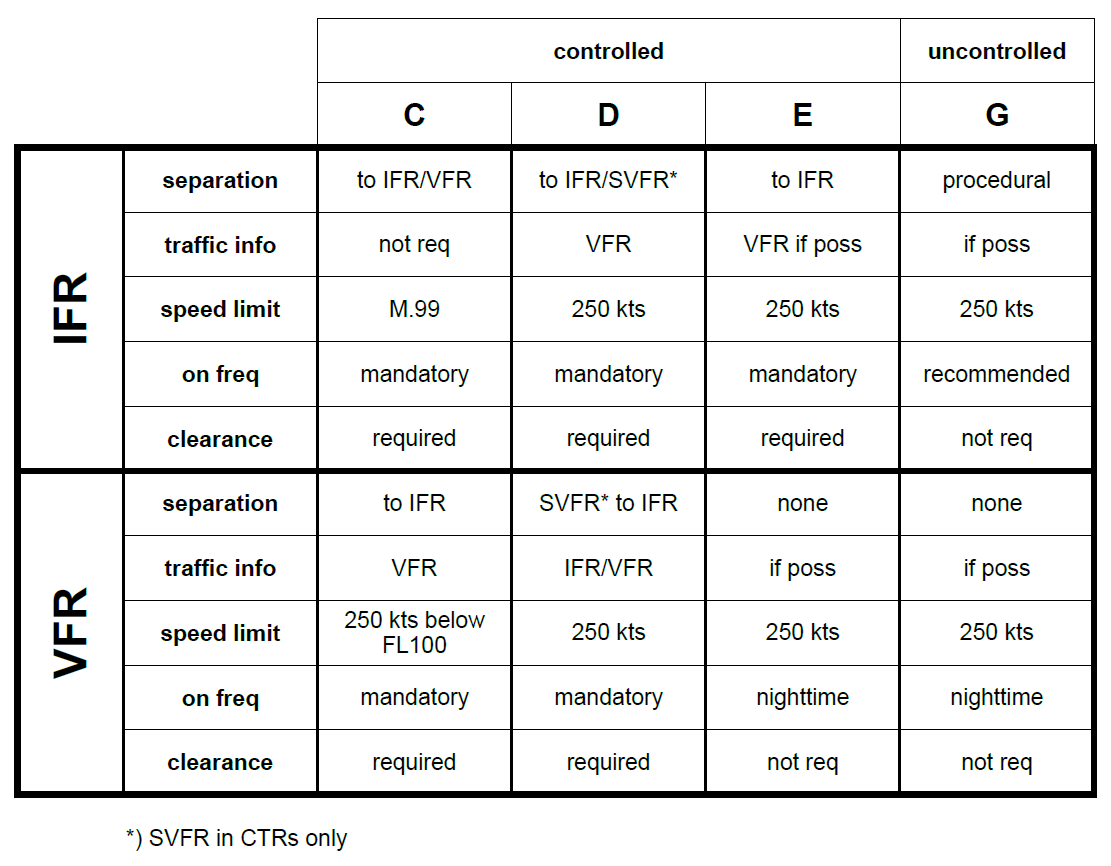](https://knowledgebase.vatsim-germany.org/uploads/images/gallery/2022-10/atd-airspace-rules.PNG)
In other words, there is obligatory radar separation between:
- (all flights in airspace A and B - does not exist in Germany)
- IFR to IFR in airspace C, D and E
- IFR to VFR and vice versa in airspace C
- Special VFR to IFR in the control zone
#### Vertical separation
The following vertical separation must be applied between two aircraft subject to separation:
| **Level** | **Vertical separation** | **Remarks** |
| FL410 - UNL | 2000 FT |
|
| FL290 - FL410 | 2000 FT | during CVSM (exception)
|
| 1000 FT | during [RVSM](https://www.skybrary.aero/articles/reduced-vertical-separation-minima-rvsm "Skybrary - RVSM") (standard) |
| GND - FL290 | 1000 FT |
|
This regulation applies to aircraft flying at altitudes as well as at flight levels. Important further information can be found in the corresponding [altimetry article](https://knowledgebase.vatsim-germany.org/books/air-law/page/altimetry "Altimetry").
Vertical separation must not be used on **final approach**, horizontal separation only is applied here.
#### Horizontal separation
The following horizontal separation must be applied between two aircraft subject to separation:
| **Level** | **Horizontal separation** | **Remarks** |
|
| FL245 - UNL | 5 NM |
|
|
| GND - FL245 | 3 NM |
|
|
| Final approach within 10 NM
| 2,5 NM
| **ONLY** if specified and approved by SOPs!
|
|
The horizontal separation is always measured as a direct line **between centers of targets**.
**Formation flights** must be separated to other traffic with **1 NM** more than the required minimum distance.
**Two formation** flights must be separated with **2 NM** more than the required minimum distance to each other.
If the required [**wake turbulence separation**](https://knowledgebase.vatsim-germany.org/books/separation/page/wake-turbulence-separation "Wake turbulence separation") is higher than the above values, it must be given priority, so that the higher value always applies.
# Wake turbulence separation
Wake turbulence: yet another abstract new term. [This video](https://www.youtube.com/watch?v=XBZULOoe94U) explains what wake vortices are and how they arise.
And what do air traffic controllers have to do with it? We have to make sure that accidents like the one shown in the video in New York don't happen again. There are minimum separation values for this depending on the maximum take-off mass of the aircraft and we as controllers need to make sure these separation distances are maintained at all times.
#### When must wake turbulence separation be applied?
Wake turbulence separation is used in areas where wake turbulence is expected.
Between aircraft with **obligatory radar separation** (see [radar separation](https://knowledgebase.vatsim-germany.org/books/separation/page/radar-separation "Radar separation")), if:
- an aircraft is directly behind a preceding aircraft at the same altitude or less than 1000ft below
- an aircraft crosses directly behind another aircraft - at its 6 o'clock position - at the same altitude or less than 1000ft below
Between aircraft in the **approach or departure phase** of flight when:
- an aircraft is directly behind a preceding aircraft at the same altitude or less than 1000ft below it
- an aircraft crosses directly behind another aircraft - at its 6 o'clock position - at the same altitude or less than 1000ft below it
- both aircraft are using the same runway or parallel runways less than 760m apart
- the aircraft use crossing or parallel runways (distance of 760m or more) and one aircraft flies through the flight path of the preceding aircraft at the same altitude or less than 1000ft below it
Wake turbulence separation does not apply to:
- approaching VFR flights
- approaching IFR flights that are performing a visual approach, have reported the preceding aircraft in sight and have been instructed to follow it and maintain their own separation
In these cases, a **wake turbulence warning (CAUTION WAKE TURBULENCE)** must be issued.
##### Departure phase
A VFR flight is in the departure phase from take-off until
- reaching 1000ft above aerodrome level or
- reaching level flight or
- entering (right) downwind
##### Approach phase
A VFR flight is in the approach phase when it is at or below 1000ft above aerodrome level and
- has entered the traffic pattern or part of it or
- has begun the final descent within a control zone
until landing.
A **touch-and-go** is considered an approaching aircraft until touchdown, from then on it is handled as a departing aircraft. A **low-approach** is considered to be an approaching aircraft until it crosses the runway threshold, after which it is considered to be a departing aircraft.
#### Wake turbulence categories
For this purpose, aircraft are divided into four wake turbulence categories (WTC) according to their maximum take-off mass (MTOM).
| WTC
| MTOM
|
| Light (L)
| MTOM ≤ 7t
|
| Medium (M)
| 7t < MTOM < 136t
|
| Heavy (H)
| MTOM ≥ 136t
|
| Super (J)
| A388; A225 |
Of course, you don't need to know how heavy each aircraft is. In addition to the aircraft type, the corresponding WTC can always be found in the flight plan.
Aircraft in the “Super” category are treated as “Heavy” above flight level 100.
#### Minimum separation values
Wake turbulence separation can either be distance-based or time-based. As a standard procedure, distance-based wake turbulence separation is used. However, there are also constellations in which this is not possible and in these cases time-based wake turbulence separation is used.
##### Distance-based
| **Preceeding**
| **Suceeding**
| **Separation value**
|
| M
| L
| 5 NM
|
| H
| L
| 6 NM
|
| M
| 5 NM
|
| H
| 4 NM
|
| J
| L
| 8 NM
|
| M
| 7 NM
|
| H
| 6 NM |
##### Time-based
With time-based wake turbulence separation, a distinction is made between the separation values of departing and approaching aircraft.
We also differentiate between a take-off from an intersection or the full runway length. Usually the values of the take-off on an intersection apply to a take-off on a crossing runway. In each case, the separation value is increased by one minute.
In contrast to distance-based wake turbulence separation there is no separation value between heavy-heavy aircraft in time-based wake turbulence separation.
##### Departing aircraft
| **Preceeding** | **Suceeding** | **Separation value** | **Separation value (intersection)**
|
| M | L | 2 min | 3 min |
| H
| L | 2 min | 3 min |
| M | 2 min | 3 min |
| J
| L | 3 min | 4 min |
| M | 3 min | 4 min |
| H | 2 min | 3 min |
##### Approaching aircraft
| **Preceeding**
| **Suceeding** | **Separation value**
|
| M | L | 3min |
| H
| L | 3min |
| M | 2min |
| J
| L | 4min |
| M | 3min |
| H | 2min |
### Examples for separation values
1. IFR departure B744 (H) behind IFR departure B744 (H) --> 4 NM
2. IFR departure C172 (L) behind IFR departure A388 (J) --> 8 NM
3. IFR approach A320 (M) behind IFR approach A320 (M) --> no wake separation needed (no value in the table for this scenario)
4. VFR approach C172 (L) behind IFR Anflug A320 (M) --> Wake turbulence warning required (for 2 minutes)
5. VFR departure C172 (L) behind IFR departure A332 (H) --> 6 NM (see table; separation required as this is a VFR departure)
6. VFR touch and go C172 (L) behind IFR departure A320 (M) --> 5 NM as soon as the C172 enters the area where wake turbulence is expected after the touch and go
Further information on wake turbulence separation can be found here.
# Runway separation
# Runway separation
Runway management is the main task of every tower controller. Without a runway, an airport obviously makes no sense. Not only do we have to use our runway as efficiently as possible in order to fully utilize the airport's capacity, but we also have to protect it accordingly, as the critical flight phases of take-off and landing take place there. Runway separation was introduced for this purpose. But what actually is runway separation? It's actually quite simple:
**The runway may only ever be occupied by one user at a time.**
Now we just have to deal with a few more questions to clearly define the concept.
Who is considered a runway user?
- Landing aircraft (i.e. aircraft with active landing clearance)
- Aircraft taking off (i.e. aircraft with active take-off clearance)
- Vehicles on the runway e.g. inspecting the runway (not implemented on Vatsim)
How long is a user considered to be an active user of a runway and when is the runway free again for the next user?
- For aircraft taking off: The runway can be used again as soon as the departing aircraft has either
- overflown the end of the runway (image b) or
- vacated the runway to the side (picture a)
- For landing aircraft: The runway can be used again as soon as the aircraft has vacated the runway (image c). The runway is considered abandoned as soon as all parts of the aircraft have rolled over the stop bar of the CAT1 holding point.
[](https://knowledgebase.vatsim-germany.org/uploads/images/gallery/2022-11/atd-pistenstaffelung.png)
A **touch-and-go** is considered an approaching aircraft until touchdown, from then on it is handled as a departing aircraft. A **low-approach** is considered to be an approaching aircraft until it crosses the runway threshold, after which it is considered to be a departing aircraft.
An aircraft that is cleared for line-up (i.e. taxiing onto the runway, but without take-off clearance) does not count as a runway user. A line-up clearance can therefore be given in the following cases, even though the runway is still occupied according to the above criteria:
- After a landing aircraft has passed the point at which the waiting aircraft will taxi onto the runway
- After a departing aircraft has passed the point at which the waiting aircraft will taxi onto the runway
The procedure described on this page is also called “**full**” runway separation. Does this mean that there is a “half” runway separation, too? Not quite, but almost. There is also “**reduced**” runway separation (RRS), which is taught in [this article](https://knowledgebase.vatsim-germany.org/books/separation/page/reduced-runway-separation-rrs "Reduced runway separation (RRS)"). A brief teaser: with reduced runway separation, under certain conditions the runway may be used more efficiently.
# Intersecting runways
Many airports have intersecting runways either to compensate for prevailing weather conditions or to increase efficiency due to a lack of space. In Germany, Hamburg and Cologne are particularly well known for their intersecting runways.
As always, there are rules and regulations that must be observed when using the two runways simultaneously.
In this chapter, we will consider all possible combinations for using the runways.
##### Departure - Departure
In the case of two departures on intersecting runways, the second aircraft may only begin the take-off run if one of the following conditions is met:
The other aircraft is taking off and
- has taken off and has initiated a turn that excludes the possibility of undercutting the separation or
- has crossed the intersection.
##### 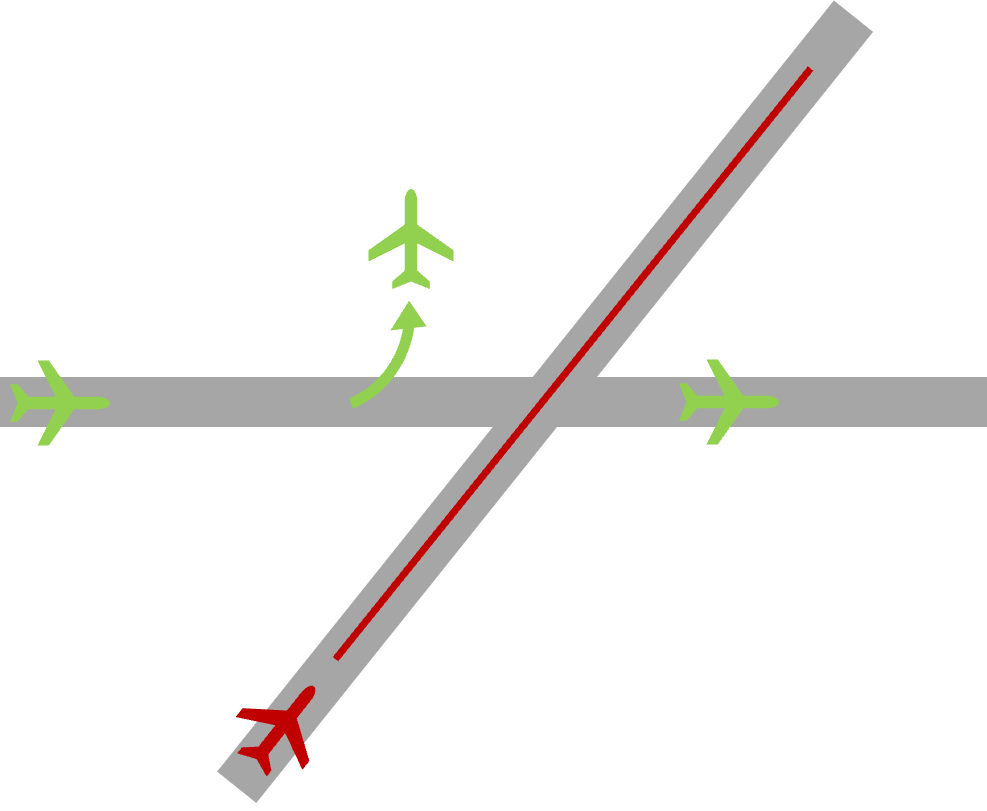Arrival - Departure
The situation is different if we have a preceding inbound, in which case the second aircraft on the intersecting runway may only begin the take-off run if one of the following conditions is met:
The other aircraft lands and
- has left the runway or
- has been instructed to stop before the intersection and has completed the landing roll or
- has crossed the intersection.
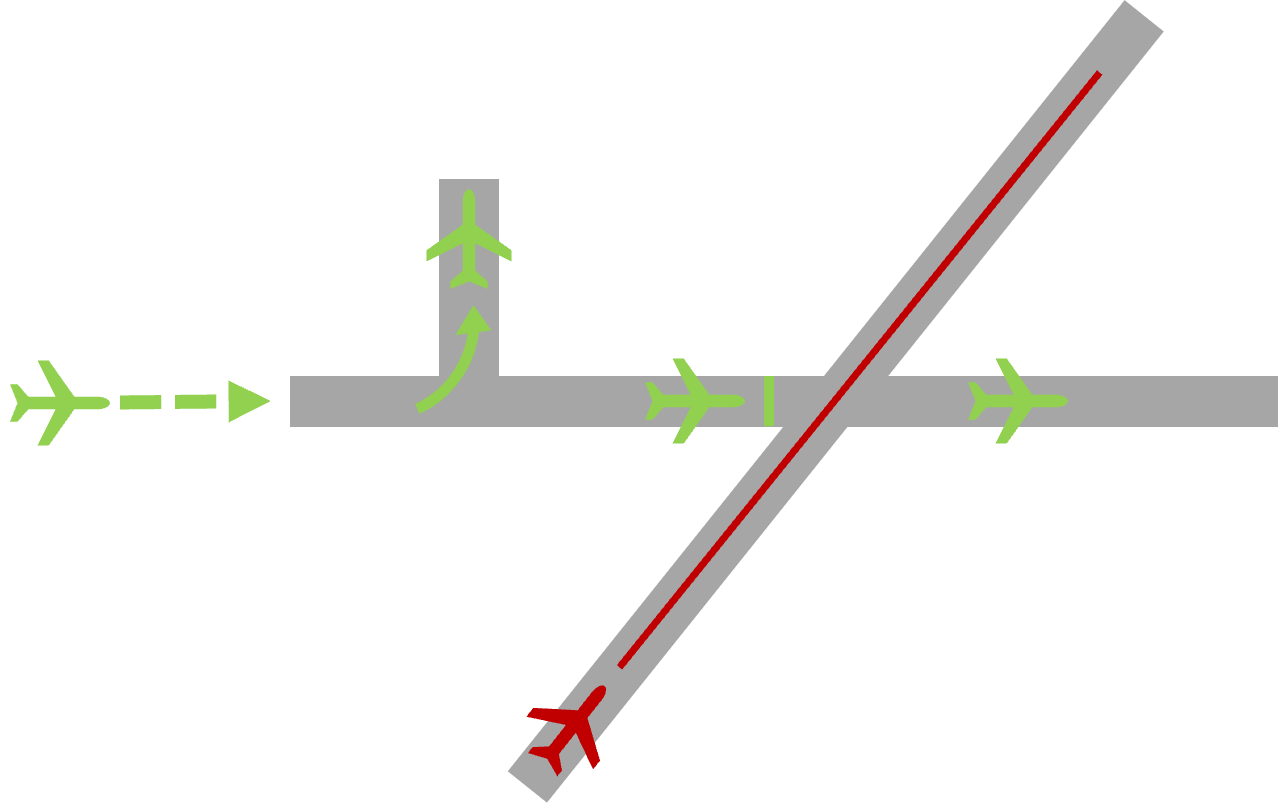
##### Abflug - Anflug
Bei einem abfliegenden Luftfahrzeug gefolgt von einem anfliegenden Luftfahrzeug auf der kreuzenden Piste, darf das folgende Luftfahrzeug den Anfang der Piste erst überfliegen, wenn eine der folgenden Bedingungen gegeben ist::
Das andere Luftfahrzeug startet und
- hat abgehoben und eine Kurve eingeleitet, die eine Staffelungsunterschreitung ausschließt
oder
- hat die Kreuzung überquert.
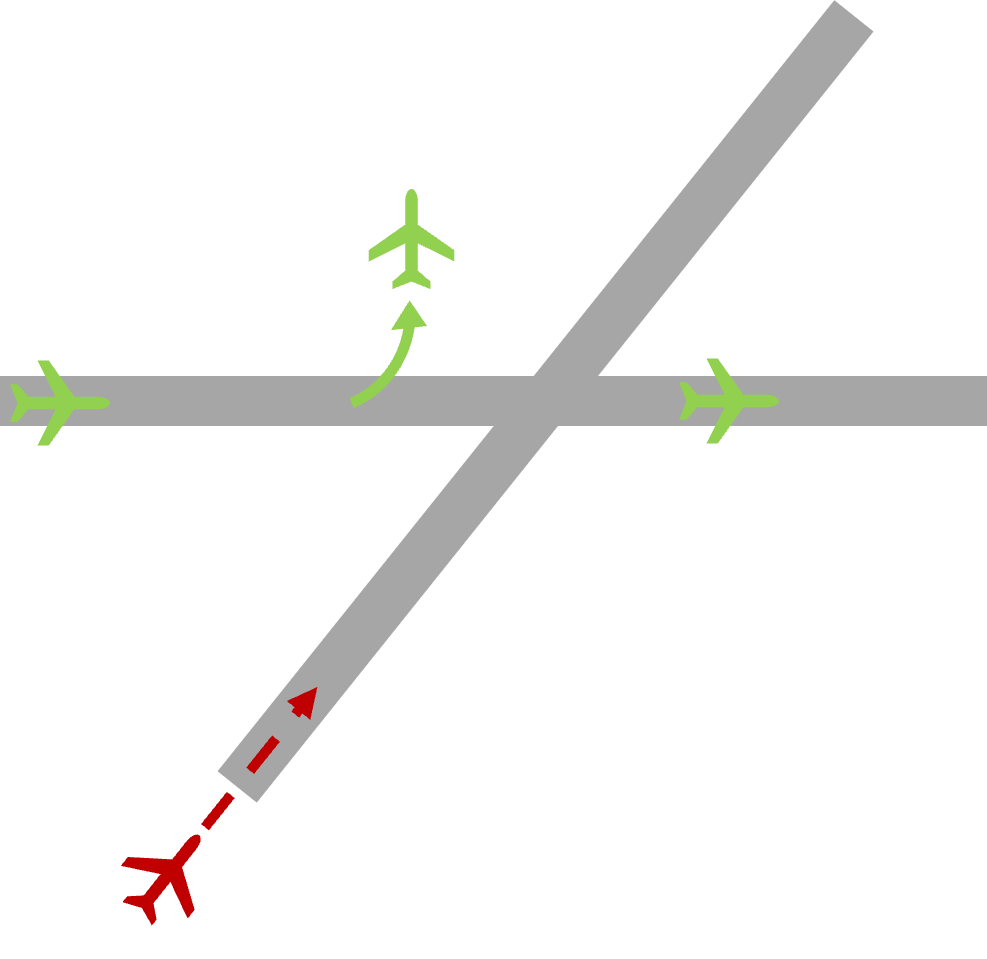
##### Arrival - Arrival
The last possibility is a landing aircraft followed by another landing aircraft on the intersecting runway. The following aircraft may only fly over the runway threshold if one of the following conditions is met:
The other aircraft is landing and
- has left the runway or
- has been instructed to stop before the intersection and has completed the landing roll or
- has crossed the intersection.
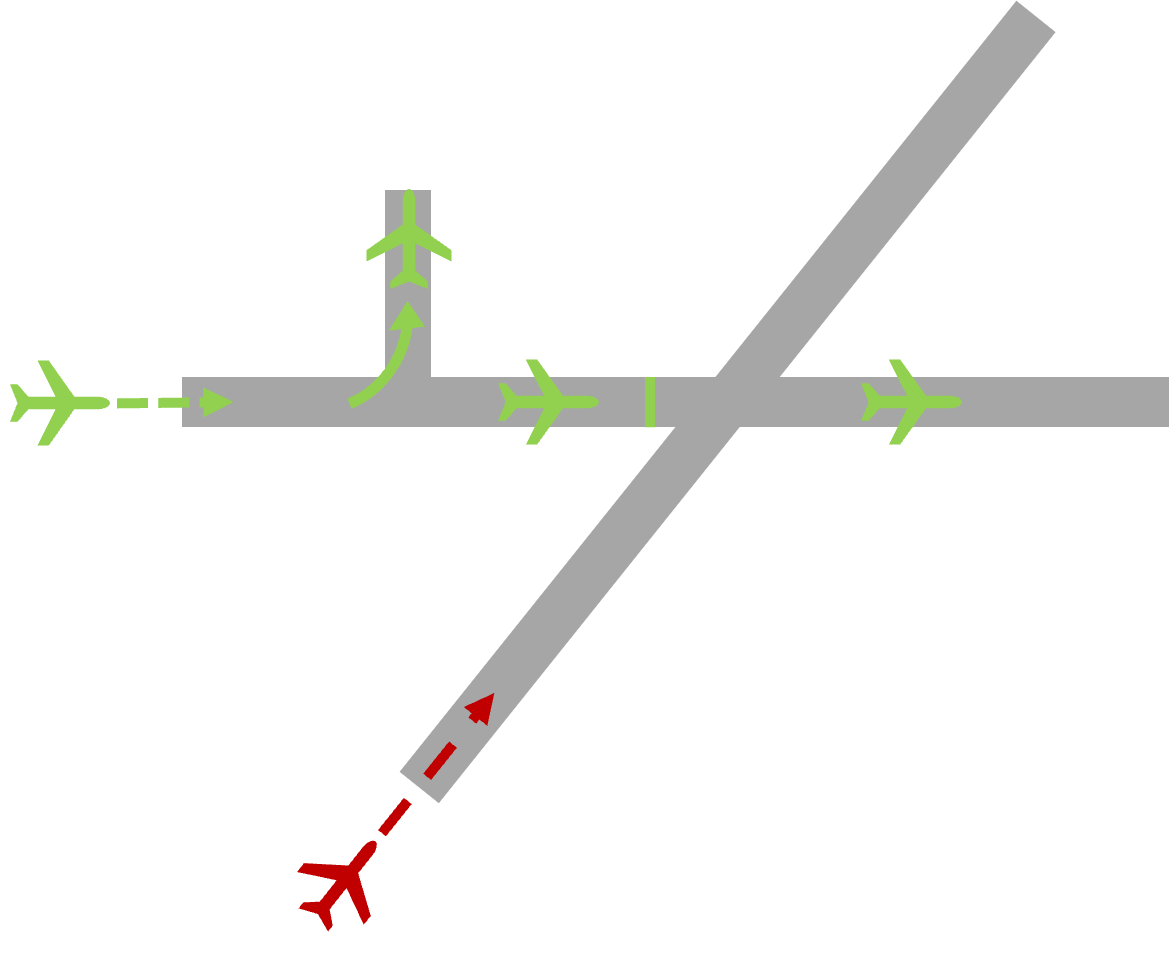
### Simultaneous use of intersecting runways
The simultaneous use of intersecting runways may only be authorized for two landing aircraft under the following conditions:
- One of the intersecting runways has an available distance between threshold and intersection of at least 2200 meters.
- An aircraft with a maximum take-off weight of up to 2000 kg lands on this runway.

All of the following conditions must additionally be met:
- VMC
- The braking action is not negatively affected.
- Both aircraft have been informed of the simultaneous landings.
- The aircraft landing on the 2200m runway has been instructed to stop before the intersection.
# Reduced runway separation (RRS)
Reduced runway separation is not a mandatory part of S1 training.
#### Requirements
Reduced Runway Separation is permitted on all international airports (ICAO code: EDD\*) apart from Erfurt. On all other airports, RRS may not be used.
ATCOs can only use Reduced Runway Separation if the following aspects are fulfilled:
- The tailwind component on the ground must not exceed 5 knots
- Ground visibility must be equal to or greater than 5 kilometers
- The ceiling must be at 1000ft AGL or higher
- Wake turbulence separation must be maintained at all times
- The braking effect on the runway must not be significantly impaired by precipitation
- On Vatsim, the braking effect is considered to be significantly impaired by precipitation: snow (SN), snow grains (SG), ice grains (PL), hail (GR) and rime (GS) - in other words, all precipitation except rain (RA) and drizzle (DZ)
- The following aircraft in the RRS sequence must receive traffic information about the preceding traffic
#### Aircraft categories
For the Reduced Runway Separation procedure, aircraft have been divided into three categories.
These three categories are:
| **CAT 1** | **CAT 2** | **CAT 3** |
| Single-engine propeller-driven aircraft with a maximum take-off weight of up to 2 tons. | Single-engine propeller-driven aircraft with a maximum take-off weight greater than 2 tons but less than 7 tons.
Twin-engine propeller-driven aircraft with a maximum take-off weight of less than 7 tons.
| All other aircraft |
| [](https://knowledgebase.vatsim-germany.org/uploads/images/gallery/2022-10/atd-rrs-lfz-kat1.png) | [](https://knowledgebase.vatsim-germany.org/uploads/images/gallery/2022-10/atd-rrs-lfz-kat2.png) | [](https://knowledgebase.vatsim-germany.org/uploads/images/gallery/2022-10/atd-rrs-lfz-kat3.png) |
| The following registrations apply in Germany:
- D-**E**
- D-**K**
- D-**M**
| The following registrations apply in Germany:
- D-**C** (up to 7 tons)
- D-**F**
- D-**G**
- D-**I**
| The following registrations apply in Germany:
- D-**C** (over 7 tons)
- D-**B**
- D-**A**
|
| Examples: C152, C172, P28A, A210, DA40, DR40, DV20, SR22
| Examples: DA62, PA34, TBM9, BE58, B350
| Examples: AT75, DH8D, C25C, CRJ9, B738, A359
|
#### Possible constellations
The use of RRS may be restricted depending on the airport. Details can be found in the SOPs.
There are four different possible constellations of these categories on a runway. We will now look at these step by step with a focus on Reduced Runway Separation.
##### Departure behind departure
- The following departure receives traffic information about the leading departure.
- If all other criteria are met, the second departure may be cleared for take-off as soon as the first departure has taken off and is a defined distance away from the second departure. The distance is specified by the LFZ-KATs (aircraft categories):
| **Preceeding**
| **Suceeding**
| **Requirement**
|
| CAT 1 / CAT 2
| CAT 1
| airborne and at a distance of 600m
|
| CAT 1 / CAT 2
| CAT 2
| airborne and at a distance of 1500m |
| CAT 3
| all
| airborne and at a distance of 2400m |
- As soon as the second departure has taken off, any applicable separation must exist.
- Example of application: First departure is a DV20 IFR, second departure a BE58 VFR. No separation must be established between the two aircraft in D(CTR), only wake turbulence separation, as the VFR is a departure. However, since light behind light does not require wake turbulence separation, I only have to consider the runway separation. Without Reduced Runway Separation, I would have to hold back the take-off clearance until the DV20 has flown over the end of the runway. Using RRS, I can now clear the following take-off as soon as the DV20 has taken off and is 1500 m away from the BE58. This means I can use the runway more effectively and have more capacity.
- The second approach receives traffic information about the approach ahead.
- If all other criteria are met, the second approach may be cleared for landing as soon as the first approach has landed and is a defined distance away from the threshold. Additionally, the first approach must continue moving and leave the runway without backtracking. Because the landing clearance is explicitly clearance to overfly the runway threshold, it must of course be issued before the threshold is crossed. If the criteria are not (yet) fulfilled, a missed approach must be instructed. The distance is specified by the LFZ-KATs (aircraft categories):
| **Preceeding**
| **Suceeding**
| **Clearance before**
| **Requirement**
|
| CAT 1 / CAT 2
| CAT 1
| aircraft crosses runway threshold
| vacating runway and at least 600m from threshold
|
| CAT 1 / CAT 2
| CAT 2
| vacating runway and at least 1500m from threshold |
| CAT 3
| all
| vacating runway and at least 2400m from threshold |
- The approach receives traffic information about departure.
- If all other criteria are met, the approach may receive landing clearance as soon as the departure has taken off and is a defined distance away from the threshold. Because the landing clearance is explicitly clearance to overfly the runway threshold, it must of course be issued before the threshold is crossed. If the criteria are not (yet) fulfilled, a missed approach must be instructed. The distance is specified by the LFZ-KATs (aircraft categories):
| **Preceeding**
| **Suceeding**
| **Clearance before**
| **Requirement**
|
| CAT 1 / CAT 2
| CAT 1
| aircraft crosses runway threshold
| airborne and at least 600m from threshold
|
| CAT 1 / CAT 2
| CAT 2
| airborne and at least 1500m from threshold |
| CAT 3
| all
| airborne and at least 2400m from threshold |
| **German** | **English** |
| G: VERKEHR C172 FLIEGT \*VON PISTE 25\* AB | G: TRAFFIC C172 DEPARTING \*ON RUNWAY 25\* |
| G: VERKEHR A320 IST \*AUF PISTE 25\* GELANDET | G: TRAFFIC A320 LANDED \*ON RUNWAY 25\* |
| G: VERKEHR PA34 LANDET \*AUF PISTE 25\* | G: TRAFFIC PA34 LANDING \*ON RUNWAY 25\* |
#### Miscellaneous and example
##### Example of the procedure
We issue a take-off clearance, the next approach is on a 3NM final. In this situation full runway separation is not so likely, so we give traffic information to the landing traffic about the departing traffic. As soon as this is done and the meteorological conditions are suitable, we can apply RRS. The traffic info can read: “DLH414, TRAFFIC A320 DEPARTING RUNWAY 26R”. Theoretically, the traffic information can also be given when the aircraft is cleared to land. However, as RRS is quite tight, it is advisable to give the traffic information as early as possible so you only have the landing clearance left to give and can keep it brief and concise later. As soon as the departing traffic has taken off and passed the prescribed distance from the runway threshold, the landing clearance can be given: “DLH414 WIND 170 DEGREES 6 KNOTS RUNWAY 26R CLEARED TO LAND”.
##### Marker in the sector file
Of course, you do not have to estimate the distances in meters. Depending on the runway direction selected in Euroscope, you will find green markers on the runway (design may vary depending on the FIR). These describe the distances for the various combinations of aircraft CATs from the start of the runway. The first marker is at 600m and the following ones at 1500m and 2400m. The picture shows an example of these markings for runway 08L in Munich. The representation may differ depending on the FIR.
**[](https://knowledgebase.vatsim-germany.org/uploads/images/gallery/2022-11/atd-rrs-marker.png)**
Requirements Independent parallel approaches (click to expand)
1. **Separate controllers** must be responsible for the separation of aircraft for each runway.
2. As soon as an aircraft is on the frequency of the approach controller, the controller must **inform** the pilot **as early as possible** that independent parallel approaches are in progress. This can also be done via the **ATIS**.
3. The runway distance must be at least **1,035 meters**.
4. The ATC radar must have a certain accuracy depending on the runway spacing. *(Not applicable on VATSIM).*
5. The **instrument approach** flown during final approach must be one of the following:
- A **precision approach** (ILS, GLS, SBAS CAT I)
- An **approach with vertical guidance (APV)**, designed according to the RNP or RNP AR navigation specification and only after subject to a safety assessment
6. The **missed approach courses** of the approaches to the respective parallel runways must diverge by at least **30 degrees**.
7. Affected aircraft must be informed as early as possible of the **expected runway** and the **instrument approach procedure**.
8. The final approach course must be flown via:
- A **published approach procedure** enabling the final approach via the Initial Approach Fix (IAF) or Intermediate Fix (IF), or
- **Radar vectors**, provided that:
- The aircraft intercepts the final approach course at an angle of no more than **30 degrees**
- The aircraft flies **straight and level for at least 1 NM** before intercepting the final
- The aircraft flies **at least 2 NM on the final approach course in level flight** before beginning descent on the glide path
9. A **Non-Transgression Zone (NTZ)** with a minimum width of **610 meters** must be displayed on radar between the runways.
10. **Before** two aircraft are established on their respective final approach courses, there must be at least **1,000 feet of vertical separation** or at least **3 NM of horizontal separation** between them.
11. Between two aircraft on the **same final approach course**, the **minimum separation must be 3 NM**, or **2.5 NM if locally approved**. Wake turbulence separation must also be applied if applicable.
Independent parallel approaches are permitted at the following airports in Germany, provided all requirements are met: **EDDF** (ILS, GLS), **EDDM** (ILS, RNP), **EDDB** (ILS), and **EDDP** (ILS).
**Requirement (1)** — that separate controllers be responsible for spacing to each runway — is **not mandatory for EDDM** due to a local exemption.
On VATSIM, the NTZ (Non-Transgression Zone) is often forgotten during independent parallel approaches. However, it is a required element (provided it is included in the NAV package). If one of the parallel aircraft enters the NTZ, the other aircraft must be issued traffic information and, if necessary, instructed to go around.
In the event of a missed approach, the parallel aircraft are procedurally separated as long as the published missed approach procedure is not deviated from.
#### **Dependent Parallel Approaches**
Dependent parallel approaches are approaches to parallel runways where **a certain prescribed radar separaration** exists between arriving aircraft on parallel runways.
#### 
**Dependent parallel approaches** may only be conducted if all of the following conditions are met:
Requirement dependent parallel approaches (click to expand)
1. The **runway distance** must be at least **915 meters**.
2. The **final approach course** must be flown via:
- A **published approach procedure** enabling final approach through the **Initial Approach Fix (IAF)** or **Intermediate Fix (IF)**, or
- **Radar vectors**
3. The **ATC radar** must meet specific accuracy requirements. *(Not applicable on VATSIM.)*
4. The **instrument approach** aligning the aircraft on final must be one of the following:
- A **precision approach** (ILS, GLS, SBAS CAT I), or
- An **approach with vertical guidance (APV)** designed in accordance with the **RNP** or **RNP AR** navigation specification and subjected to a safety assessment
5. Relevant aircraft must be informed that **approaches are being conducted to both runways**.
6. The **missed approach courses** of the respective parallel runway approaches must diverge by at least **30 degrees**.
7. Before two aircraft are established on final approach, there must be either:
- **1,000 feet of vertical separation**, or
- **3 NM of horizontal separation** between them
8. Between two aircraft on the **same final approach course**, the **minimum separation must be 3 NM**, or **2.5 NM if locally regulated**. Wake turbulence separation must also be applied, if necessary.
9. The **minimum radar separation** between two aircraft on **parallel runways** depends on the runway spacing:
- **2 NM** if the runways are **more than 2,529 meters** apart
- **1.5 NM** if the runways are **less than 2,529 m but more than 1,097 m** apart
- **1 NM** if the runways are **less than 1,097 m but more than 915 m** apart
In Germany, dependent parallel approaches are authorized at the following airports, provided all requirements are met:
**EDDF** (ILS, GLS), **EDDB** (ILS), **EDDP** (ILS), **EDDV** (ILS).
A minimum separation of 1.5 NM between two aircraft on parallel approaches applies at all of these airports.
In the event of a missed approach, the aircraft are procedurally separated as long as the published missed approach procedure is not deviated from.
If **neither independent nor dependent** parallel approaches are possible (e.g., due to insufficient runway spacing at EDDL and EDDK), the two final approaches must be **treated** as if they were to a **single runway** in terms of radar separation. That means a minimum of **3 NM**, or 2.5 NM if locally regulated, must be maintained between two aircraft on parallel runways (see below).
This mode is known as "**alternating**" or "**staggered**" approaches.
If the runway spacing is less than 760 meters, wake turbulence separation may also need to be applied.
#### **Independent Parallel Departures**
Independent parallel departures involve simultaneous takeoffs from parallel runways, where **no prescribed radar separation** exists between the parallel departures.
[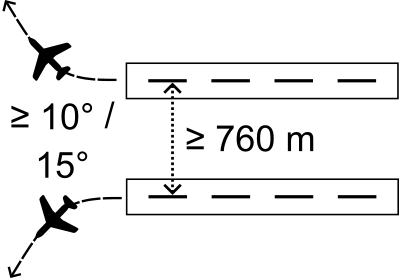](https://knowledgebase.vatsim-germany.org/uploads/images/gallery/2025-05/iJQdepartures.png)
**Independent parallel departures** may only be conducted if all of the following requirements are met:
Requirements for independent parallel departures (click to expand)
1. **Runway distance** must be at least **760 meters**
2. The **departure tracks** must diverge by at least:
- **15 degrees** immediately after takeoff, or
- **10 degrees**, provided that:
- Both aircraft are flying RNAV or RNP departure routes, and
- The turn begins no later than 2 NM after the end of the runway
3. **ATC radar** capable of identifying aircraft **within 1 NM** from the runway end is available
In Germany, independent parallel departures are permitted at the following airports, if all conditions are met:
**EDDM**, **EDDB**, **EDDP**
If **independent parallel departures are not possible** (e.g., generally at EDDF, EDDL, EDDK, EDDV), then radar separation of **3 NM** must be applied between departures.
For runway distance less than 760 meters, wake turbulence separation may also be required.
#### **Segregated Parallel Operations**
Segregated parallel operations refer to the simultaneous use of one runway for departures and the other for landings. Each runway may be used exclusively for takeoffs, exclusively for landings, or for both.
[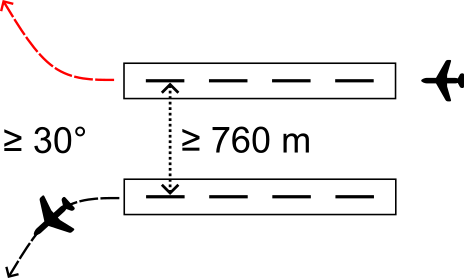](https://knowledgebase.vatsim-germany.org/uploads/images/gallery/2025-05/segregated.png)
**Segregated parallel operations** may only be conducted if all of the following conditions are met:
Requirements for Segregated Parallel Operations (click to expand)
1. The **runway distance** must be at least **760 meters**. This minimum can be reduced by 30 meters for every 150 meters the arrival runway is ahead of the departure runway. Conversely, it must be increased by 30 meters for every 150 meters the arrival runway is behind the departure runway.
2. The **departure tracks must diverge immediately** after takeoff by **at least 30 degrees** from the missed approach course of the parallel runway.
3. The **instrument approach** flown on final must be one of the following:
1. A precision approach (ILS, GLS, SBAS CAT I) and/or a lateral guidance approach (RNP)
2. A Surveillance Radar Approach (SRA)
3. A visual approach
In Germany, segregated parallel operations are permitted at the following airports, if all conditions are met:
**EDDF**, **EDDM**, **EDDL**, **EDDB**, **EDDP**.
Requirement (1), so the minimum runway spacing of 760 m, is not required at EDDF (center and southern runway) and EDDL due to local exemptions. Although the runway spacing there is less than 760 meters, segregated operations can still be conducted under certain conditions, as detailed in local SOPs.
If **segregated operations are not possible** (e.g., at EDDV, EDDK, or due to insufficient divergence between a specific SID and the missed approach course), the parallel runways must be **treated like a single runway** for the in terms of departure and arrival separation. In that case, **runway separation** between departures and arrivals must be applied.
However, **ground movements** (e.g., behind a landing, crossing, line-up) are **exempt** and may still occur in parallel with an ongoing departure or landing.
Here is a summary of what is and isn't allowed if segregated parallel operations are **not** permitted:
| [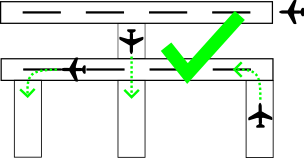](https://knowledgebase.vatsim-germany.org/uploads/images/gallery/2025-05/parallelerlaubt1.png)
*A parallel line-up, runway crossing, or vacating is always allowed during a landing*
| *A departure must have overflown the runway end (or turned away) before an aircraft on the parallel runway crosses the threshold to land* |
| [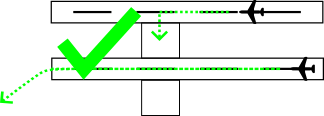](https://knowledgebase.vatsim-germany.org/uploads/images/gallery/2025-05/parallelerlaubt3.png)
*If a landing is assured, a departure on the parallel runway may be cleared for takeoff.*
| [](https://knowledgebase.vatsim-germany.org/uploads/images/gallery/2025-05/parallelverboten.png)
*If an arrival crosses the threshold and the parallel departure hasn't yet overflown the runway end (or turned away), this would be a loss of separation if segregated parallel operations are not approved.*
|
## Reduced radar separation on final approach
Even when parallel runways are available, independent or dependent parallel approaches may not always be possible. In such cases, the standard radar separation of 3 NM must be met.
However, under certain conditions, the minimum radar separation on final approach can be reduced. Two cases are distinguished:
- Reduced radar separation on final approaches to parallel runways
- Reduced radar separation on the same final approach
#### **Reduced Radar Separation on Final Approaches to Parallel Runways**
The **longitudinal separation** between two aircraft on final approaches to parallel runways may be reduced to 2.5 NM, if all of the following conditions are met:
Requirements Reduced Radar Separation on Final Approaches to Parallel Runways (click to expand)
1. Both aircraft must be **within the 10 NM final approach segment**
2. **Wake turbulence separation** is **not required**
3. **Approach speeds must be closely monitored** and, if necessary, adjusted
In Germany, reduced radar separation on final approaches to parallel runways is permitted at the following airports, if all conditions are met: **EDDF**, **EDDM, EDDL, EDDB**, **EDDV** (only northern and southern runway)
#### **Reduced Radar Separation on the Same Final Approach**
Although this type of separation doesn't relate directly to parallel runways, it is only applied at major German airports with parallel runways, and is included here for completeness.
Radar separation between two aircraft on the same final approach can be reduced to 2.5 NM, provided that all of the following conditions are met:
Requirements Reduced Radar Separation on the Same Final Approach (click to expand)
1. Both aircraft must be **within** the **10 NM final approach** segment
2. **Wake turbulence separation** is **not required**
3. **Approach speeds** must be closely **monitored** and adjusted if necessary
4. The **average runway occupancy time** must be **no more than 50 seconds** *(not applicable on VATSIM)*
5. Reported **braking** action must be “**good**”
6. The ground radar must have an update rate of 5 seconds or less
7. The controller must be able to **see the runway and taxiways**, either visually or via ground radar
8. The pilot must be **instructed** to **vacate the runway quickly**
9. Procedures for applying reduced separation must be **published in the AIP**
In Germany, reduced radar separation on the same final approach is permitted at the following airports, if all conditions are met: **EDDF**, **EDDM**
# Visual separation
Visual separation refers to two possibilities of separation used in different cases. There is **visual separation in the vicinity of aerodromes** (relevant for the tower controller, depending on the situation possibly also for the approach controller) and there is the **delegation of separation to the pilot during descent or climb** (relevant for the approach controller).
### Visual separation in the vicinity of aerodromes
In the vicinity of an aerodrome, the prescribed radar separation (not wake turbulence separation or runway separation!) between two aircraft may be reduced if:
**1.** adequate separation can be maintained by the tower controller, provided that they have both aircraft in sight continuously and traffic information is issued to at least one aircraft *or*
**2.** both pilots have each other in sight and report that they can maintain adequate separation *or*
**3.** if one aircraft is following another, the pilot of the succeeding aircraft reports that they have the preceding aircraft in sight and can maintain adequate separation
The terms “vicinity of the aerodrome” and “adequate separation” are not defined in detail. Therefore, this procedure should be used sensibly. Examples are a swing-over in Frankfurt from the 25L to the 25C if a pilot is simultaneously approaching the 25R in parallel or the avoidance of a missed approach if there is a risk of falling below the minimum separation.
| **Phraseology example: Own Separation - Final**
|
| G: DLH123, traffic, A320, 2 o'clock, report in sight and able for own separation
|
| A: DLH123, traffic in sight and able
|
| G: DLH123, cleared visual approach runway 25C, in case of missed approach, climb on runway track to 5.000 feet, maintain own separation to mentioned traffic
|
Another regular use case for this type of visual separation is multiple **consecutive departures** in different directions.
Here's an example: GWI9086 turns directly north after departure from runway 23L, whereas SWR3BZ initially flies straight ahead. The departures thus turn away from each other quickly. In this configuration, the radar separation may be reduced if the TWR sees both aircraft according to point 1 and issues traffic information to the following departure. This means the takeoff roll of the following departure can already begin as soon as (reduced) runway separation is ensured. There is no prescribed minimum separation in the air.
[](https://knowledgebase.vatsim-germany.org/uploads/images/gallery/2025-09/screenshot-17.png)*GWI9086 has just passed the 2400m marker, thus reduced runway separation exists and SWR3BZ can begin the takeoff roll.*
Since the TWR on Vatsim cannot actually look out the window, weather conditions under which this procedure can be applied are defined in the SOPs of the respective airport (e.g. only in VMC).
It is important that the following aircraft remains on the tower controller's frequency until 3 NM / 1000 feet are ensured. Therefore, the pilot must be told before departure to remain on the TWR frequency (except at airports where this is standard practice). As soon as the 3 NM / 1000 feet are ensured, the pilot can switch to the departure controller
[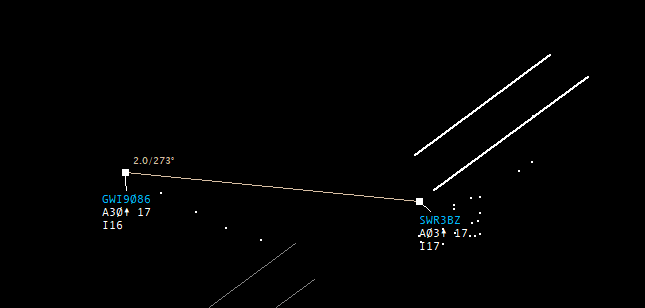](https://knowledgebase.vatsim-germany.org/uploads/images/gallery/2025-09/screenshot-18.png)
*When SWR3BZ is airborne, the distance is initially < 3 NM, thus SWR3BZ must remain on the TWR frequency (although here it is more than 1000 feet, however it is not ensured that this will remain the case).*
*[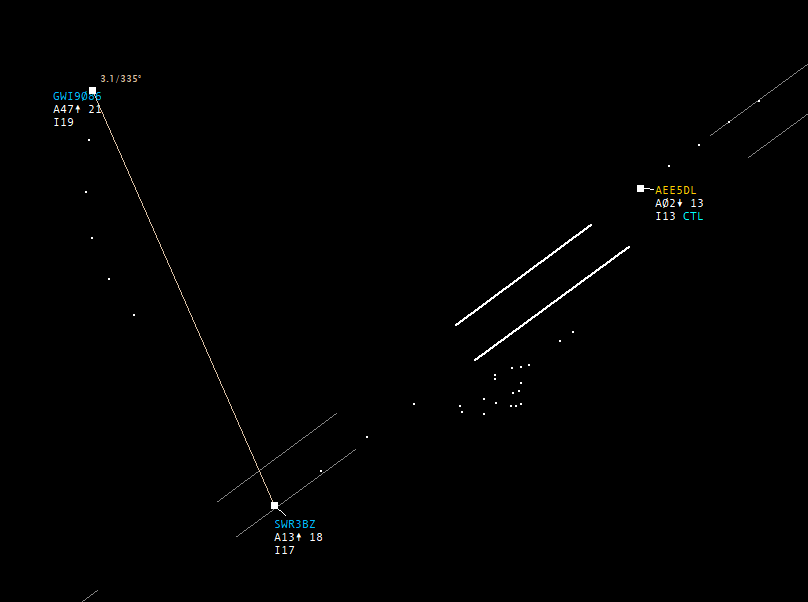](https://knowledgebase.vatsim-germany.org/uploads/images/gallery/2025-09/screenshot-19.png) A short time later, due to the different departure routes, the 3 NM are ensured. Now SWR3BZ can be handed over to the radar controller.*
| **Phraseology example: Visual Separation between Departures**
|
| G: SWR3BZ, after departure remain on this frequency, preceding Boeing 737 on a diverging SID (alternatively e.g.: preceding Boeing 737 turning right 1 mile end of runway), wind..., runway 23L cleared for takeoff.
|
| A: SWR3BZ, roger, cleared for takeoff runway 23L.
|
### Delegation of separation during climb or descent
Under certain conditions, the responsibility of maintaining separation between two flights requiring separation may be delegated to the pilot. The conditions are:
- Daytime
- Below FL100
- Airspace E or D
- VMC
- Only during climb or descent
- Both pilots involved agree to the procedure
| **Funkbeispiel Own Separation - CLB/DES**
|
| G: DLH123, REPORT FLIGHT CONDITIONS AND LEVEL
|
| A: DLH123, VMC, FL80
|
| G: DLH123, TRAFFIC IS PA42, 1 O'CLOCK 5 MILES SAME DIRECTION, 1000 FEET BELOW, REPORT IN SIGHT
|
| A: DLH123, TRAFFIC IN SIGHT
|
| G: DLH123, ADVISE ABLE TO MAINTAIN OWN SEPARATION UNTIL PASSING FL60
|
| A: DLH123, AFFIRM
|
| G: DEHHH, TRAFFIC 7 O'CLOCK 5 MILES AIRBUS 320 HAS YOU IN SIGHT. MAY HE DESCEND THROUGH YOUR LEVEL MAINTAINING OWN SEPARATION
|
| A2: DEHHH, AFFIRM
|
| G: DLH123, DESCEND 5000 FEET QNH1013, MAINTAIN OWN SEPARATION AND VMC UNTIL PASSING FL60
|
| A: DLH123, DESCENDING 5000 FEET QNH1013, MAINTAINING OWN SEPARATION AND VMC UNTIL PASSING FL60
|
| G: DLH123, DEHHH, CLEAR OF TRAFFIC
|
# Procedural separation
With procedural separation, two aircraft can fall below the 3 NM required for radar separation under certain circumstances .
Procedural separation is used in the following examples:
##### Independent parallel approaches (IPA)
In Frankfurt, Munich and Berlin, under certain conditions so-called **independent parallel approaches** (IPA) are possible. This means that two aircraft may approach the respective north and south runway in parallel. At this point, they have neither 3 NM nor 1,000 feet of separation. Nevertheless, the procedure is legal, as both aircraft are on non-overlapping flight paths. As the aircraft come relatively close to each other at comparatively high speeds, certain **conditions** must be met. These include the following:
- Both aircraft must perform a precision approach (ILS, GLS, RNP\*)
- The final course is intercepted by an angle of maximum 30 degrees
- Before turning on the final course, the aircraft shall fly at least 1 NM straight and in level flight
- Before intercepting the glide path, the aircraft shall fly at least 2 NM in level flight on the final course
- Both aircraft must be established on the LOC **before** falling below 3 NM or 1,000 feet
- An NTZ (non-transgression zone) must be displayed on the radar - if an aircraft enters this zone, the parallel aircraft must go around
- A controller must monitor compliance with the procedure for each runway
- There must be no meteorological conditions that could cause aircraft to deviate from their track (e.g. thunderstorms)
\*RNP approaches only when locally permitted - details may be found in the SOPs
Details and exceptions can be found in the SOPs of the respective airports.
##### Dependent parallel approaches (DPA)
In addition to independent parallel approaches, there are also **dependent parallel approaches** (DPA). Here, too, two aircraft may fly with less than 3 NM separation, but not completely parallel. In Frankfurt, for example, 1.5 NM must still be maintained between the aircraft. The requirements for this are less strict than for IPAs.
Details can be found in the SOPs of the respective airports.
##### Independent parallel departures
In Berlin and Munich, there are departure routes with non-intersecting flight paths and obstacle protection areas which are far enough apart to use the departure routes simultaneously. This is why they are referred to as **independent parallel departures**. Here too, the aircraft come closer to each other than 3 NM and/or 1,000 feet. As with independent parallel approaches, the controllers must strictly monitor compliance with the routes in order to be able to react immediately with traffic information and avoidance instructions in the event of a deviation.
Details can be found in the SOPs of the respective airports.
##### Geographical separation
At certain airfields, special VFR aircraft are considered separated to IFR if they are located above a geographically defined point (e.g. a roundabout, a highway intersection, a sports facility, etc.). Even then, the distance may be less than 3 NM. This procedure is often only permitted for certain SVFR pilots (e.g. police and rescue helicopters).
The use of geographical separation on Vatsim must be explicitly regulated in the SOPs, otherwise it is not permitted.